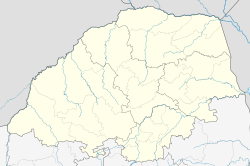Hoedspruit
Hoedspruit | |
|---|---|
 Courtyard at Hoedspruit Airport | |
| Coordinates: 24°21′S 30°58′E / 24.350°S 30.967°E | |
| Country | South Africa |
| Province | Limpopo |
| District | Mopani |
| Municipality | Maruleng |
| Area | |
| • Total | 24.13 km2 (9.32 sq mi) |
| Population (2011)[1] | |
| • Total | 3,157 |
| • Density | 130/km2 (340/sq mi) |
| Racial makeup (2011) | |
| • Black African | 39.4% |
| • Coloured | 5.0% |
| • Indian/Asian | 2.8% |
| • White | 52.3% |
| • Other | 0.5% |
| First languages (2011) | |
| • Afrikaans | 44.8% |
| • English | 19.7% |
| • Northern Sotho | 11.7% |
| • Tsonga | 6.2% |
| • Other | 17.6% |
| Time zone | UTC+2 (SAST) |
| Postal code (street) | 1380 |
| PO box | 1380 |
| Area code | 015 |
Hoedspruit (Afrikaans for Hat Creek) is a town situated at the foot of the Klein Drakensberg (Afrikaans for "Small Dragon Mountains" range), in the Limpopo province of South Africa, on the railway line from Tzaneen to Kaapmuiden.[2]
History
[edit]Pre-Colonialization
[edit]The Stone Age artifacts and sites from all three periods suggest continuous use by early humans. Early and Middle Iron Age sites near Hoedspruit have been excavated on the Happyland farm, dating between AD 450 and 1000.[3]
Colonialization and Settlement
[edit]Dawid Johannes Joubert became the initial owner of Hoedspruit farm, acquiring the land in 1844 and settling in the region between the Blyde and present-day Zandspruit rivers.[2]
On 5 May 1848, Joubert officially registered the farm at the land office in Ohrigstad, granting Hoedspruit its first recognition and registration as a town and municipality.[2]
In the 1850s, Ohrigstad grew into the central town of the area, but only older settlers were permitted to live in and around Ohrigstad itself. Younger settlers under the age of 45 were encouraged to move farther away. Consequently, a group of young men, all under 45, established their settlement between the mountain and the Blyde River on a farm they named Jonkmanspruit (meaning "young man river/stream/creek"). Other young men settled on nearby farms named Welverdiend (meaning "well deserved") and Driehoek (meaning "triangle") due to the farm's shape. These original names still exist in the area today and are located around the periphery of the original Hoedspruit farm.[2]
The name "Hoedspruit" was given by Dawid Johannes Joubert himself after a significant incident in 1844 when a severe cloud burst caused the river, now known as Zandspruit, to flood rapidly. During the event, Joubert lost his hat in the raging river. Given that a hat was a valuable resource for a farmer in those times, serving various purposes, losing it was a major event for Joubert. Consequently, he named the river "Hoedspruit," meaning "Hat River/stream/creek" in reference to the river that took his hat.[2]
Dawid Johannes Joubert owned another farm in the Ohrigstad area and split his time between both farms. Sadly, in 1860, he was killed by a leopard while on his farm in Ohrigstad.[2]
During Joubert's ownership, the Hoedspruit farm that he registered with the Land Office in Ohrigstad was extensive, stretching from the Blyde River to the Klaserie River and encompassing the present-day town center.[2]
Around the same time, a dispute arose between the Portuguese in Lourenço Marques (Maputo) and the South Africans in the Transvaal Republic over the international border near the Drakensberg mountain range behind Hoedspruit. The Portuguese claimed it was the border between Mozambique and South Africa, while the South Africans argued it was the Lebombo Mountains. To settle the matter, President Oom Paul Kruger of the Transvaal Republic ordered a proper land survey study to determine the official border.
Since there were no qualified land surveyors in South Africa then, three main surveyors were brought in from Europe, including Von Weilligh, Vos, and Gillfillan. While in the Transvaal Republic, President Kruger instructed the surveyors to mark the farm boundaries along the Drakensberg mountains before their return to Europe, as the region was gaining attention for potential settlement opportunities. The large farms, including the original Hoedspruit farm, were divided into smaller registered farms, still owned and operated by a single farmer.[2]
With limited knowledge of local cultures, languages, and customs, the European land surveyors assigned European names of cities, states, and countries to the official farms they were formalizing. As a result, the area is now populated with farms bearing names such as Essex, Madrid, Berlin, Richmond, Chester, Moscow, Dublin, Dundee, and Fife.[2]
Economy
[edit]Due to its proximity to private game reserves and the Kruger National Park, ecotourism and big game hunting are major contributor to the local economy. Agriculture is the other major regional industry focusing on citrus and mango production.[4]
Air Force Base Hoedspruit and Eastgate Airport
[edit]Air Force Base Hoedspruit is home to 19 Squadron, South African Air Force helicopter unit.[5] The civil Eastgate Airport, which shares the Air Force base's airfield,[6] is served by several charter operators.[7]
References
[edit]- ^ a b c d "Main Place Hoedspruit". Census 2011.
- ^ a b c d e f g h i "History of Hoedspruit". www.hoedspruit.co.za. Retrieved 16 May 2023.
- ^ "The History of Hoedspruit – South Africa - Nomads Den". 25 December 2023. Retrieved 12 September 2024.
- ^ "Hoedspruit Town – Raptor's View". Retrieved 12 September 2024.
- ^ "Hoedspruit Airport Manyeleti - Easy flight access to Kruger Airport and Manyeleti Game Reserve". Manyeleti.com. Retrieved 13 May 2015.
- ^ "Hoedspruit Airport - General Information". Eastgateairport.co.za. Retrieved 13 May 2015.
- ^ "Hoedspruit Airport - Private Charters". Eastgateairport.co.za. Retrieved 13 May 2015.[permanent dead link]



